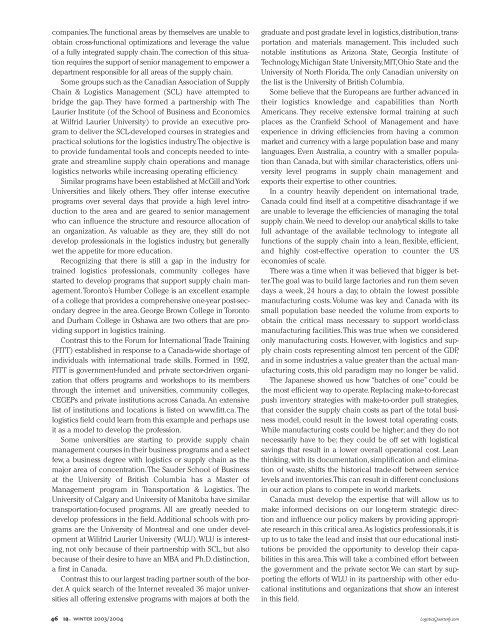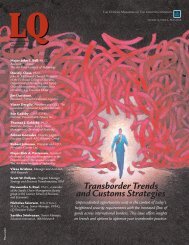Reverse Logistics - Logistics Quarterly
Reverse Logistics - Logistics Quarterly
Reverse Logistics - Logistics Quarterly
You also want an ePaper? Increase the reach of your titles
YUMPU automatically turns print PDFs into web optimized ePapers that Google loves.
companies.The functional areas by themselves are unable to<br />
obtain cross-functional optimizations and leverage the value<br />
of a fully integrated supply chain.The correction of this situation<br />
requires the support of senior management to empower a<br />
department responsible for all areas of the supply chain.<br />
Some groups such as the Canadian Association of Supply<br />
Chain & <strong>Logistics</strong> Management (SCL) have attempted to<br />
bridge the gap. They have formed a partnership with The<br />
Laurier Institute (of the School of Business and Economics<br />
at Wilfrid Laurier University) to provide an executive program<br />
to deliver the SCL-developed courses in strategies and<br />
practical solutions for the logistics industry.The objective is<br />
to provide fundamental tools and concepts needed to integrate<br />
and streamline supply chain operations and manage<br />
logistics networks while increasing operating efficiency.<br />
Similar programs have been established at McGill and York<br />
Universities and likely others. They offer intense executive<br />
programs over several days that provide a high level introduction<br />
to the area and are geared to senior management<br />
who can influence the structure and resource allocation of<br />
an organization. As valuable as they are, they still do not<br />
develop professionals in the logistics industry, but generally<br />
wet the appetite for more education.<br />
Recognizing that there is still a gap in the industry for<br />
trained logistics professionals, community colleges have<br />
started to develop programs that support supply chain management.Toronto’s<br />
Humber College is an excellent example<br />
of a college that provides a comprehensive one-year post-secondary<br />
degree in the area. George Brown College in Toronto<br />
and Durham College in Oshawa are two others that are providing<br />
support in logistics training.<br />
Contrast this to the Forum for International Trade Training<br />
(FITT) established in response to a Canada-wide shortage of<br />
individuals with international trade skills. Formed in 1992,<br />
FITT is government-funded and private sector-driven organization<br />
that offers programs and workshops to its members<br />
through the internet and universities, community colleges,<br />
CEGEPs and private institutions across Canada.An extensive<br />
list of institutions and locations is listed on www.fitt.ca. The<br />
logistics field could learn from this example and perhaps use<br />
it as a model to develop the profession.<br />
Some universities are starting to provide supply chain<br />
management courses in their business programs and a select<br />
few, a business degree with logistics or supply chain as the<br />
major area of concentration.The Sauder School of Business<br />
at the University of British Columbia has a Master of<br />
Management program in Transportation & <strong>Logistics</strong>. The<br />
University of Calgary and University of Manitoba have similar<br />
transportation-focused programs. All are greatly needed to<br />
develop professions in the field.Additional schools with programs<br />
are the University of Montreal and one under development<br />
at Wilifrid Laurier University (WLU).WLU is interesting,<br />
not only because of their partnership with SCL, but also<br />
because of their desire to have an MBA and Ph.D.distinction,<br />
a first in Canada.<br />
Contrast this to our largest trading partner south of the border.A<br />
quick search of the Internet revealed 36 major universities<br />
all offering extensive programs with majors at both the<br />
46 LQ winter 2003/2004<br />
graduate and post gradate level in logistics,distribution,transportation<br />
and materials management. This included such<br />
notable institutions as Arizona State, Georgia Institute of<br />
Technology,Michigan State University,MIT,Ohio State and the<br />
University of North Florida.The only Canadian university on<br />
the list is the University of British Columbia.<br />
Some believe that the Europeans are further advanced in<br />
their logistics knowledge and capabilities than North<br />
Americans. They receive extensive formal training at such<br />
places as the Cranfield School of Management and have<br />
experience in driving efficiencies from having a common<br />
market and currency with a large population base and many<br />
languages. Even Australia, a country with a smaller population<br />
than Canada, but with similar characteristics, offers university<br />
level programs in supply chain management and<br />
exports their expertise to other countries.<br />
In a country heavily dependent on international trade,<br />
Canada could find itself at a competitive disadvantage if we<br />
are unable to leverage the efficiencies of managing the total<br />
supply chain.We need to develop our analytical skills to take<br />
full advantage of the available technology to integrate all<br />
functions of the supply chain into a lean, flexible, efficient,<br />
and highly cost-effective operation to counter the US<br />
economies of scale.<br />
There was a time when it was believed that bigger is better.The<br />
goal was to build large factories and run them seven<br />
days a week, 24 hours a day, to obtain the lowest possible<br />
manufacturing costs.Volume was key and Canada with its<br />
small population base needed the volume from exports to<br />
obtain the critical mass necessary to support world-class<br />
manufacturing facilities.This was true when we considered<br />
only manufacturing costs. However, with logistics and supply<br />
chain costs representing almost ten percent of the GDP,<br />
and in some industries a value greater than the actual manufacturing<br />
costs, this old paradigm may no longer be valid.<br />
The Japanese showed us how “batches of one” could be<br />
the most efficient way to operate.Replacing make-to-forecast<br />
push inventory strategies with make-to-order pull strategies,<br />
that consider the supply chain costs as part of the total business<br />
model, could result in the lowest total operating costs.<br />
While manufacturing costs could be higher; and they do not<br />
necessarily have to be; they could be off set with logistical<br />
savings that result in a lower overall operational cost. Lean<br />
thinking, with its documentation, simplification and elimination<br />
of waste, shifts the historical trade-off between service<br />
levels and inventories.This can result in different conclusions<br />
in our action plans to compete in world markets.<br />
Canada must develop the expertise that will allow us to<br />
make informed decisions on our long-term strategic direction<br />
and influence our policy makers by providing appropriate<br />
research in this critical area.As logistics professionals,it is<br />
up to us to take the lead and insist that our educational institutions<br />
be provided the opportunity to develop their capabilities<br />
in this area.This will take a combined effort between<br />
the government and the private sector. We can start by supporting<br />
the efforts of WLU in its partnership with other educational<br />
institutions and organizations that show an interest<br />
in this field.<br />
<strong>Logistics</strong><strong>Quarterly</strong>.com







